#need a character i can apply this to stat
Explore tagged Tumblr posts
Text
wake up, besties, new meme template just dropped

#loving the translator notes on this webnovel im reading#viridi posts 2023#saw this note and i couldnt NOT turn it into a template#its just too funny#need a character i can apply this to stat#viridi speaks#meme#meme template
18 notes
·
View notes
Text
Red Dead Redemption 2 was so real for creating the most in-depth, realistic clothing system I've ever seen in any game, and exclusively using it on burly, unhygienic men.
You choose every layer, every accessory, with dozens to hundreds of each to choose from. You can go in and fine-tune minute details like whether or not to roll up the shirt sleeves, or button the collar, or whether to wear your pants under your boots. These clothes get dirty in real time depending on what you do in the game. Mud, dust and blood linger unless washed off. Every garment has a warmth rating based on its material, and the game calculates what temperatures an outfit is suitable for based on the combined total. Dressing too cold or warm for the weather causes health debuffs.
You can choose which way he parts his hair, and whether he gels it. If you eat too much he gets bulkier and gains a double chin, and if you eat too little he can go underweight and get all bony and sallow. Both of these states come with stat changes. His hair and beard grow in real game time, and you need to routinely style and shave his facial hair if you want any style other than a full Santa. You need to bathe him regularly or people will start commenting on his BO, and he'll start visibly appearing filthy long before that. He sunburns in the sun, and in the heat he becomes slick and glossy with sweat.
This shit is IN DEPTH. It blows the customization systems of actual fashion-centric games like tf2, Monster Hunter and Splatoon out of the water in every regard. They honestly look basic in comparison. It's a paradigm shift for sure once you experience RDR2's level of customization. Everything else starts to feel smaller.
The player character all this customization is applied to, and I simply cannot stress this enough, is a 36 year old, 6'3" smoker weighing well over 200 pounds, with facial hair thicker than a sheepdogs, forearms like gnarled tree trunks and a dark, dense forest of body hair covering every reasonable surface. His skin is pocked and marred with scars from a rugged, nomadic lifestyle, and his teeth are the colour of cornbread. He has a thick southern accent, is a known mean drunk and knows how to skin pretty much any North American animal. He has never worn deodorant, flossed or moisturized. He eats canned beans, fruit and the like by simply pouring them into his mouth and gulping, often while walking or riding a horse at full gallop.
I can think of NO better use case for such customization. Not some fresh-faced little twink, not some busty anime babe. Just a gross, hairy, unwashed homeless dude with crippling self esteem issues and a chest broader than a barrel laid lengthwise. A non fashion-centric game, certainly a non-fashion centric character, but for some reason the best clothing and customization system ever concieved, bar none. What the fuck.
#rdr2#red dead redemption 2#red dead redemption two#arthur morgan#rdr arthur#rdr2 arthur#rdr2 fandom#video game#video games#gaming#rockstar games
2K notes
·
View notes
Text
So my home ttrpg group is between longform games right now, and I have been planning to bring a bunch of games to them this weekend as options for what we might play next. However, I have been trying to figure out how to talk about the games in a way that doesn't rely as much on me explaining the vibes to them.
I know that people have a bunch of qualitative categories for how they explain games, but I find the idea of saying things like Dark Fantasy OSR, or Lesbian Goofball PBTA less helpful when talking about how games actually play, especially when two games in the same category are like, wildly different in the way they use their frameworks.
So I invented a 6 axis, 1 to 5 star rating scale for TTRPGs that you are free to borrow when talking to groups, or whatever.
TTRPG 5 Star Rating Matrix
Width
What is the scope of this game? Is it narrowly about one thing or does it encompass many types of play? (Credit to friend of the blog @ostermad-blog for this one, they came up with it from my draft)
Weight
How much cognitive load does the player need to bear? Do rules often need to be referenced verbatim? Can those rules fit on a handout?
Wargame
Is the player expected to apply tactical acumen? Is movement tracked tightly or loosely? Does a bad build punish a player?
Writers Room
How much are players expected to make narrative choices and drive the story without the rules scaffolding them? Does this game fall apart without excellent improvisational storytellers?
(Prep)Work
Does this game require a lot of pre-planning by the facilitator? Are there intricate systems to attend to outside of table play? Can I put in the same amount of time as other players and still have everyone leave happy?
Whimsy
Expected tone of the game. Does this game have difficult thematic elements baked in? Is the core subject or role in the game high or low risk?
Here are some games I know well and how I calibrated them:

I have breakdowns of what each star rating means below the cut if you're curious. Happy Gaming!
Width
⭐ - As written, the game has basically one mode of play, or one thematic core that it meditates on. May have phases, but textural difference is minimal.
⭐⭐ - As written, there are at least two modes of play, but the scope of that play is highly thematically focused or highly dependent on using the game’s own lore. Might have only one kind of character (e.g. Mech Pilot) that it supports. Has limited tools outside of the primary mode of play.
⭐⭐⭐ - Has a variety of modes of play, but may be rigid in their execution. Might encompass multiple kinds of characters (e.g. Doctor, Lawyer, fighter) or character options. The narratives that this game tells within its setting are narrowed, a three word description tells you what kind of stories it can tell with consistency.
⭐⭐⭐⭐ - Loose framework, but with some kind of thematic grounding. Describing the framework in 3 words doesn’t tell you the kind of stories that the game tells (e.g. Dark Fantasy, Star Wars Romp).
⭐⭐⭐⭐⭐- As written, this game is designed in such a way that it doesn’t put specific limits on what sorts of stories that it is meant to tell. It might ask players to define abilities or stats for themselves. The Facilitator is going to pitch a thematic grounding on top of the rules set.
One Star Examples: For the Queen, Dialect, Honey Heist Five Star Examples: Fate Core, Savage Worlds, GURPS
Weight
⭐ - It is reasonable for a player to be able to recite the rules from memory. The game may be prompt based, or driven by a flow of rules that are read aloud as played.
⭐⭐ - Players can hold most of the most important information about the game in their heads, with a page or less of rules reference needed to play smoothly. This reference could all fit neatly on the character sheet if one is present.
⭐⭐⭐ - Everything a player needs to know about the game is visible on less than 3 sheets of reference. Players are more or less expected to know exactly how their own abilities work in precise detail, and are unlikely to make a mistake in executing them.
⭐⭐⭐⭐ - Players make extensive use of multiple reference sheets to keep rules moving smoothly. No external tools are needed, but players memorizing the details of all of their abilities is taxing.
⭐⭐⭐⭐⭐- Players and facilitators will prefer to make extensive use of external tools or reference to keep play moving smoothly. Expecting a player to have the exact details of their abilities memorized is not reasonable.
One Star Examples: For the Queen, Stewpot, Mobile Frame Zero: Firebrands Five Star Examples: Dungeons and Dragons 3-5e, Lancer, Edge of the Empire
Wargame
⭐ - As written, this game does not treat combat as mechanically different from any other aspect of play, or does not include narrative violence at all.
⭐⭐ - While players may engage in combat, it is minimally different from regular play. There may be tools or abilities for players to use to conduct a fight, but the texture of those fights is thematic, not mechanical. Narrative and consequence drive the action, not hit points.
⭐⭐⭐ - As written, combat has its own set of rules. This game may have some elements of buildcrafting, but either it is difficult to build something that doesn’t work, or the player may meaningfully invest in other modes of play and still find a commensurate level of satisfaction. If combat occurs, spacing is kept in mind, but is tracked in relative terms (range bands) or highly simplified (zone based combat).
⭐⭐⭐⭐ - This game has buildcrafting that is somewhat mandatory if players wish to survive a fight, but there is still a meaningful choice in choosing a non-combat role. It may use a grid or a spacing system to help players visualize the combat. Fights are driven by mechanics, not by narrative.
⭐⭐⭐⭐⭐- To enjoy this game, players must spend time buildcrafting. If a player’s build is suboptimal, there may be significant parts of the intended experience that will either feel tedious, or that the player will not have meaningful access to. This game is played on a grid.
One Star Examples: Wanderhome, Dialect, Belonging Outside Belonging Five Star Examples: Lancer, Dungeons and Dragons 3-5e, Valor
Writers Room
⭐ - Players in this game are not expected to provide much in the way of narrative substance. Story is something that is driven by external input or tools, and players are there to imagine and react. The player need not separate the self from the character they play in any meaningful way.
⭐⭐ - The mechanics of this game drive most of the narrative, or else the narrative is set for the players by an external source or player. Players are encouraged to play optimally rather than dramatically, but do have room for expressing the identity of their character within the game’s mechanical frameworks.
⭐⭐⭐ - While the game does provide strong scaffolding to tell a story, the players present are expected to drive the story within those frameworks. The game’s systems create and resolve conflict on their own, but works best when the players are willing to choose the dramatically interesting option even if it mechanically non-optimal.
⭐⭐⭐⭐ - The game provides some mechanical tools that create and resolve drama, but there is a significant expectation that the players are buying into and driving the game’s thematic concepts. Players are the ones deciding what the scenes should be and when to end them, but mechanics still help determine outcomes.
⭐⭐⭐⭐⭐- The players are expected to drive the narrative at all times. Tools for deciding what scenes to do and when to end them are limited, optional, or vague. There is no meaningful scaffolding that creates conflict or resolution, it is incumbent on those present to manifest those things.
One Star Examples: Alice is Missing, Ribbon Drive, For the Queen Five Star Examples: Wanderhome, Systemless RP
(Prep)Work
⭐ - Facilitators are not expected to do work outside the time at the table. All rules can be read while the game is played. No memorization is needed.
⭐⭐ - This game expects the facilitator to have read the rules in advance, but the rules are so few that they can be run from a single reference sheet. At times, the facilitator must think about and potentially advance and adjust the narrative of the game behind the scenes. Prep is qualitative; answering questions about where the narrative is going to go, who will be there etc. The game can be run smoothly predominantly as improv.
⭐⭐⭐ - This game expects the facilitator to not only know the rules, but to imagine scenarios where the group must play. However, the scope of the scenario design is limited and qualitative. It takes a bit of pondering and perhaps a sketch and a few words of notes. Alternatively, the facilitator must design simple foes or track a simple background system. The work is trivial, and can be done with a bit of time before session.
⭐⭐⭐⭐ - The facilitator of this game is expected to have run systems between games, or created usable maps or scenarios. Generally, games at this level have some reduced wargaming component. The facilitator might need to engage in enemy design, but the work is limited or imminently reusable. The work is non-trivial, and failing to do it will somewhat impact the quality of play.
⭐⭐⭐⭐⭐- The facilitator of this game puts in significant time between sessions engaging in game design activities. They are expected to plan narratives, write NPCs, draw maps, run significant background systems, and design enemies and combat encounters. The work is significant outside of play, and failing to do it beforehand will result in a worse table experience.
One Star Examples: For the Queen, Alley-Oop, Lasers and Feelings Five Star Examples: Lancer, D&D 3-5e, Stars Without Number, Edge of the Empire
Whimsy
⭐ - This game’s thematic core is considered dark, taboo, or difficult, and separating the game’s mechanical features from this subject matter is next to impossible. Games with horror elements almost certainly fit within this category. These games encourage extensive pre-play safety talks.
⭐⭐ - This game is designed to look at dark subject matter, but doesn’t expect the player to spend all of their time there. Players explore difficult topics, but may get to choose what topics to explore, or when to explore them. Games with political messaging/commentary tend to fit this category. These games encourage pre-play safety talks.
⭐⭐⭐ - This game may have dark aesthetics, but doesn’t enforce them mechanically. Alternatively, there are mechanics that address difficult topics in broad strokes, but players are given leeway in the rules with how any difficult topics are approached. These games may encourage safety talks.
⭐⭐⭐⭐ - This game may have the option to explore dark topics, but none of the mechanics are tied to such topics. This game may have violence in its aesthetics, but players may choose to adjust the aesthetics at the table to suit their comfort. These games tend not to talk about safety in their text.
⭐⭐⭐⭐⭐- This game is designed to focus on thematic material that is considered to be relatively safe. The game is unlikely to tread into violence or trauma without effort.
One Star Examples: Trophy Dark, Dungeon Bitches, Vampire the Masquerade Five Star Examples: Honey Heist, Princess World, Beach Episode
The system here isn't about what's good or bad, to be clear. I think there are good and bad games at every level of these categories, but when I think about what my game group is good at and comfy with, I don't think we go in for things at like the 5 end of the Writers Room scale. It's too much work, and most of them aren't pro improvisers.
Similarly, if we play another game that is a 4 or 5 on the PrepWork category, I don't have time to run it these days. So this helps me make practical choices about our next game.
#ttrpg#indie ttrpg#game design#dnd#ttrpgs#ttrpg design#d&d#lancer rpg#steal this#safety tools#five star ttrpg matrix
527 notes
·
View notes
Text
I've said it before and I'll say it again,
Arthur Aguefort is not BBEG material
1: He's too powerful. CR does not apply to Aguefort, nor does 20+ levels of Wizard. The man is an enigma, timeless yet still aged, and does magic that he created (yet not perfected) himself. You cannot fight a man who has grabbed the sun.
2: He's too chaotic. Boss Fights should inspire a sense of danger, and Aguefort routinely escapes awkward conversations by turning into birds. He can travel through time but decided to return at the end of Junior Year rather than the beginning. He made Gilear the Vice Principal.
3: It would be an insane departure from his normal vibe. Aguefort seems to enjoy watching others do the work and having fun adventures rather than getting involved directly in world-ending catastrophes. He's more of a cheerleader than any kind of instructor, and however much he resembles Gandalf, I do not believe he could be tempted by the Ring.
4: If someone were to mind-control him or otherwise convince him to fight the Bad Kids, THEY would be the BBEG, not Aguefort himself. Arthur is, at best, a miniboss - and he would enjoy that immensely.
5: He doesn't have a stat block. I vaguely remember Brennan on an Adventuring Academy saying something about how certain NPCs don't need stat blocks, and I'm certain Aguefort fits the bill. You cannot put Arthur Motherfucking Aguefort in a box. It's just as comical to give him 20 STR as it is to give him 12. The poison that knocked out Ostentatia Wallace for half a school year had zero effect on him. He died from a gunshot to the head and then replaced God for ten months. He had sex with a phoenix. How do you put that on a character sheet.
#disagree? get in the comments#d20#fantasy high#junior year#fhjy#brennan lee mulligan#arthur aguefort#d20 memes#dimension 20
288 notes
·
View notes
Text
Introduction to the OSR
what's an OSR? it's a game that's kinda like old-school D&D. or is old-school D&D. or is compatible with old-school D&D. an OSR game generally has some or all of the following principles:
low character power with highly lethal combat. in old-school D&D a 1st-level fighter has d8 hit points and a longsword does d8 damage, and you die at 0HP. this is not to ensure characters die all the time but to emphasize the next bullet point:
emphasis on creative problem solving. most situations cannot be solved by straightforward use of your abilities (such as charging into every situation with swords drawn, if a fighter), so the game tests lateral, outside-the-box thinking.
emphasis on diegetic progression. spells are found, not obtained automatically on level-up. you get XP by finding gold more than killing monsters. most of your cool abilities come from magic items. making alliances & hiring followers is encouraged.
focus on managing inventory, resources, risk, and time. the players are constantly faced with meaningful decisions; this is the heart of the game.
very sandbox-oriented. the focus on creative problem solving means the game must be accommodating to players taking a course of action the GM didn't plan for. use lots of random tables to generate emergent story. some elements of new simulationism.
high tactical transparency, i.e., the optimal course of action is rarely system-specific, and ideally very possible for a new player to intuit.
usually semi-compatible with old D&D, but not always. usually rules-lite, but not always.
what does the OSR mostly NOT do?
focus on character builds. these change the focus too much to be on the rules than the fiction, can create situations where stuff everyone should be able to do is an ability locked to one class, and impede tactical transparency.
resolve everything with a die roll. combat uses dice to be scary, unpredictable and most importantly not your default course of action. everything else should bring up dice rarely - dice are your plan B when your plan A fails. the best plans need no dice.
use linear storytelling or put players into a writer/GM role. linear storytelling gets in the way of the decision-making so core to the playstyle; letting players write details into the setting is mutually exclusive with them discovering it.
rules for everything. 400 pages of crunch is worse at simulating a believable world than the GM and players' shared understanding. OSR games rely constantly on GM ruling.
mostly still applies to all the above. making your system a "pure" OSR game comes second to doing what's best for your game.
System recommendations
old D&D or a retroclone
old-school D&D - or old school essentials or basic fantasy or swords & wizardry, which are old D&D's mechanics repackaged with quality-of-life tweaks (and the upside of not giving WOTC your money) - are usually the go-to when recommending someone's first OSR game. they're actually not my first pick, though!
PROS:
very complete, with more robust rules than a lot of the lighter games on this list.
100% compatibility: most OSR adventures are statted for old school essentials. converting them to other OSR systems is usually simple, but not 1-for-1.
easier to find games for. anyone interested in the OSR space knows what old school essentials is.
CONS:
jank. these games largely still have weird saves, level limits for non-humans, some still have descending AC, etc etc. it's not that bad but it is there
i hate thief skills. lots of essential dungeoneering actions are locked to the thief class as abilities, with abysmally low success chances. this is stuff i prefer being handled without a roll. thieves in this system suck and make everyone else worse at dungeon crawling by existing.
there's just lots of really cool shit in other systems i'm about to go into that you just don't get here
Knave 1e and its various hacks
this is a 7-page super-lightweight system that boils everything down to just the essentials.
rolling a character takes like 5 minutes. roll stats, roll gear, roll traits, go. done. it's great.
characters are defined entirely by stats and gear, no classes. wanna be a fighter, have high strength and carry a big sword and armor. wanna be a wizard, have high intelligence and fill your inventory with spells. item slots are elegant and pretty limited.
initiative is instant: roll d6. 1-3, monsters go first. 4-6, PCs go first. swingy, but god it is so smooth and shaves like the most boring 5 minutes off of every combat
monsters are so very elegant. old D&D gives monsters a "hit dice" rating to determine their HP, e.g. a 3HD monster rolls 3d8 for hit points. knave takes this number (HD) and uses it for attack rolls and saves (aside from exceptionally bad/good saves), so a knave statblock looks something like this.
spells are all one or two sentences long & extremely easy to remember.
7 pages is so light. i have the system basically memorized.
DOWNSIDES: there's no dungeon crawling rules (standard for meatier OSR games & something i consider essential) and no real bestiary, though the second point isn't a huge deal cause they're so easy to make. it also kinda assumes you already know how to run OSR games, so there's very little real advice or guidance.
KNAVE HACKS
knave 1e is in creative commons & comes with an editable word doc for you to publish with modifications, so there's a ton of variants (there was a spreadsheet of them somewhere, but i can't find it).
Grave is a favorite - i'm two years into a grave campaign and it's fantastic. it's a dark-souls-y version of knave with some really elegant innovations.
you have a set number of deaths before you for-reals die, as every character plays an undead as is dark souls tradition. makes it good for OSR beginners! being able to tell when you're close to your final death is really good - it lets you emotionally prepare for losing your character & raises the stakes more the more you die. (though honestly you should probably cut the number of extra deaths in half, it's super generous)
XP and gold are combined into one resource, souls. legendary creatures drop big souls you can make into magic items. this has ended up being the coolest thing in my current campaign. my players love finding powerful souls to make into magic items it's so fun
uses preset packages of stats/gear instead of knave's rolled ones, filling the role of more traditional character classes. has the wonderful side effect of not making you get stuck with low stats cause you rolled bad one time.
you have stamina equal to your empty item slots. you spend stamina on spells if you're a caster, or free maneuvers (on top of your attack at no action cost) if you're not. it's super elegant.
there's 3 classes of spells: wizardry for intelligence, holy magic for wisdom, and witch stuff for charisma. nice and intuitive.
there's a page of 50 magic items each a couple sentences long. this PDF is worth it just for the magic items.
DOWNSIDE: see the downsides for knave 1e. all still apply.
i enjoyed grave so much i made a variant of it with the dark souls bits removed (and some dungeon crawl rules added!) to use for my standard fantasy campaigns.
Knave 2e
sadly knave 2e is not purchasable yet (i backed it on kickstarter so i have access, though). but when it comes out i highly recommend it.
much larger and denser than knave 1e. it finally has dungeon crawling rules, it has GM and player guidance, everything is refined and the layout is so so nice and readable.
combat is a bit more interesting than 1e. you can break your weapon against an enemy to deal max damage. you get a free maneuver on high attack rolls.
there's rules for stuff like alchemy, warfare, building a base. it all kicks ass.
there are so many goddamn tables. i rifle through it anytime i need inspiration.
DOWNSIDES: some of the new rules are a little untested & wonky. introducing randomness into how often your rations spoil or your lights go out can cause issues.
Mausritter
you play tiny little mice! in a world full of big dangerous things that want to eat mice. cat = dragon. you get it. what more could you want
the mouse thing is just super intuitive. you get the dynamic between you and the big scary lethal world. fantastic OSR game to introduce kids
nice and robust ruleset; nothing feels missing
tons of super nice GM stuff! faction rules, tools for rolling up hexcrawls and dungeons, plenty of tables
super clean readable layout. font isn't too small to avoid being intimidating. guidance is really nice and clear.
combat is autohit. super fast & lethal.
100% free
look mausritter is just. good. i wanna run it so bad someday
Worlds Without Number
sort of a middle ground between OSR stuff and 5e. paid version here free version here
lots of classes, at least in the paid version. the free version comes with just the warrior, expert and mage. there's feats and more of a focus on builds than most OSR games. if you like more mechanical build variety than a typical OSR game, this is a great game for you!
extremely good multiclassing. y'know how in most games if you just mash together two classes you think are cool you'll end up with a total mess? not here! every combo is viable and works fine! easily the best multiclassing of any game i've touched
an absurd amount of GM stuff and tables. easily more than any of the other stuff i've praised for also having them. but personally i haven't dug into them as much, so i can't really comment on them
skills the way modern D&D has them. you roll dice and try to beat a target number. i don't tend to like rolled skills, but most people do, so if that's your thing WWN has them
DOWNSIDES
the layout is terrible. everything is a huge wall of text with very little use of bold text or bullet points to draw attention to the important bits. the table of contents has like 15 things in it for a 400-page book! i couldn't find any of the paid-version-exclusive classes for like a month after i bought it! looking up rules is a nightmare.
the way the default setting handles "evil races" is like an exaggerated parody of all the problematic aspects of how D&D handles it. like, it wants so bad for you to have an excuse to genocide sentient free-willed people. but at least the default setting is easy to chuck in the trash
Dungeon Crawl Classics
the goal of this system is to take all of the crazy gonzo moments people remember playing old-school D&D in their childhood and turn all of that up to 11 while cutting the stuff that doesn't add to that. i think a lot of its innovations have ended up kind of standard in newer OSR stuff (like fighters getting maneuvers with their attacks), but it still has more to offer.
the funnel: you start the game with four randomly rolled dipshit peasants that you then throw into a meatgrinder to get horribly killed. you pick one of the survivors to be your 1st-level character.
maneuvers: fighters roll an extra die with each attack that gets bigger as you level. if it's a 3 or higher, you get to do a cool thing on top of your attack. pretty standard for OSR games, but this game popularized it!
crit tables: fighters also get more crits and nastier crits as they level. every crit, you roll on the crit table. maybe you chop off a dude's arm. maybe you just knock them over. maybe you shatter their shield. it's very cool
spell tables: i don't really like roll-to-cast mechanics, generally. but DCC goes so all-in on roll-to-cast that it still looks fun as hell to watch. you cast a fireball and maybe it goes how you want. or maybe you explode, or you nuke everything in a half-mile radius, or from now on you permanently ignite flammable materials you touch, or whatever. casters just have to put up with turning into a weird mutated mess across a campaign
there's no dungeon crawl rules, no encumbrance - this game is all about the big over-the-top wacky shit, and is not really interested in the more down-to-earth number crunching. it's more in the you-die-hilariously-all-the-time area of OSR than the you-avoid-death-through-clever-play area. not really my thing but the system knows exactly what it wants to be and i respect it
iron halberd
this one is mine! as the author i'm not qualified to tell you what isn't good about my system, so just assume it's worse than i make it sound, but here's a bunch of the selling points
semi-random character creation where you flip back and forth between rolling dice and getting your own input. roll stats, pick ancestry. pick starting gear kit, roll different dice based on which kit you picked. etc etc. stats are random but all equally viable (no rolling incredibly low or high stats). every time i run this game the character creation is a hit. seriously go roll up a character it'll sell you on the whole thing
you start out a lot stronger than a standard OSR character but grow way more slowly. i don't like 4th-level characters being 4 times as strong as 1st-level ones; HP never gets that high. emphasis is more on diegetic progression instead.
way too many subsystems for alchemy, crafting, strongholds, warfare, renown, rituals, likes 9 pages of magic items, a whole subsystem for becoming a cleric mid-campaign. i couldn't help myself i love this shit
in my current campaign we had a player permanently sacrifice some max HP to become a necromancer after deliberating on whether that's a good idea for like thirty seconds, which instantly made me think my necromancy system is a success
also free
Adventure recommendations
(in rough order of size)
Moonhill Garden (by Emiel Boven): look at this. look at it! this is like the best template for a little dungeon in an OSR game. all of the little factions are tied together. this would be a great oneshot to introduce people to an OSR system with.
A gathering of blades (by Ben Milton): a system-neutral, one-page sandbox. i ran this for an iron halberd game and it went super well. lasted like 7 sessions. highly recommend.
The Waking of Willowby Hall (by Ben Milton): a single dungeon with a million things going on. it's super chaotic with half a dozen different factions crashing into each other and a big angry goose. highly recommend, especially for kids
The Black Wyrm of Brandonsford (by Chance Dudinack): small sandbox with a fun fairytale vibe and a very fleshed-out little town. and a big nasty dragon.
Evils of Illmire (by Zack Wolf): this is a very dense, entire campaign's worth of hexcrawl in a very compact package for like $5. it doesn't do anything particularly new, but the value-for-money is absurd and it's a really good template for how to do a sandbox if you're used to 5e adventures
Ask me anything!
if anything here is unclear or intrigues you, send me asks! i love helping people get into OSR games. i'll link frequently asked questions here if i get any.
#osr#nsr#ttrpg#d&d#iron halberd#knave#worlds without number#dungeon crawl classics#mausritter#l2j archive
540 notes
·
View notes
Text
The 1980 Dallas RPG was a Soap Opera Wargame?
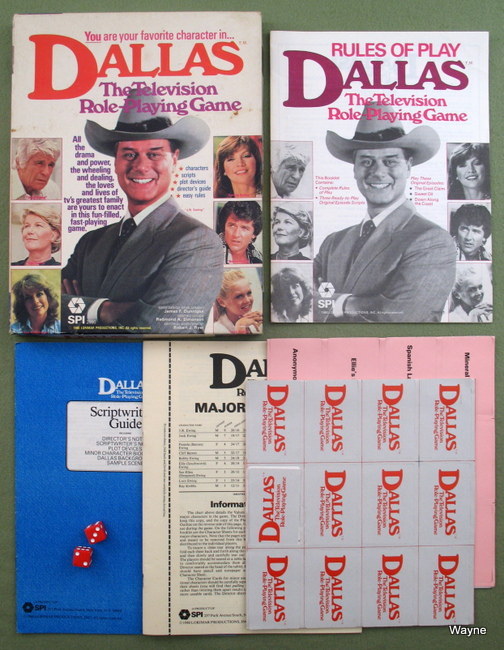
In 1980, SPI, a company known for its wargames did a strange thing and published an RPG based on the Dallas tv show. If you don't know anything about the tv show, don't worry, I will protect you. It's too late for me though. You go on ahead. Basically, it was a hit TV show of big money family feuding. Imagine Succession but it was written in the 1980s and instead of TV news, it was an oil company. Unlike the show, the RPG wasn't a hit. The art director of the game famously wrote that they printed 80,000 copies and that was 79,999 more than people wanted. That one person seemed to be this person's grandma who bought it for him to save his soul from D&D/Satan.
What is this game though? Well, James F Dunnigan, founder of SPI and designer of legendary wargame, Panzerblitz, seems to have applied his analytical mind to the internecine squabbles of Dallas and decided that, if you think about it, petty family drama isn't so different from CIA covert ops. And he was right.
As you'd expect from a wargame, the rules are dry and clinical to a fault. You start by picking one of the 9 characters from the show - JR, Jock, Sue Ellen, Pam, etc. They all have stats like Persuasion, Coercion, Seduction. And these stats have attack/defend values. For example, JR has a Coercion of 24 because he's a real jerk. Sue Ellen has a Seduction resist of 18, but it's 20 against JR, because again, he seems to have been a real jerk. This game genuinely went out of its way to make sure you know JR's wife really really doesn't want to go near him.
Each character starts the session ("episode") with a secret story-based objective. Jock wants to run an angry former employee out of town, JR wants to cheat an Arab oil magnate out of 100 million dollars, Sue Ellen wants to do a favour for an old boyfriend. Yeah, what can I say? Some of these objectives feel more important than others. Regardless, you achieve these objectives by controlling 4 or more specific minor characters and organisations by the end of the game. For example, to enact his 100 million dollar plan, JR has to control the Ewing Oil Company, Mustafa Quattara, Professor Bayard, the reporter Mary Cleef, and so on. But characters' objective overlap so Pam also wants Mustafa Quattara and Jock also wants Professor Bayard. These conflicting goals means players need to scheme, negotiate and attack each other so they can win.
The sessions play out in five rounds. Each round, the GM sets the scene. Then, the players can negotiate and make deals. Then, we enter the conflict phase where each player makes three moves - either trying to gain control of uncontrolled NPCs, or attacking another player to steal an NPC from under them, or protecting their own NPCs. And the game throws in little curveballs every round: Oops, some of JR's drinking buddies are in town and he can't say no to them, so his character is out of this round. Hopefully the player has some NPCs that they can use to act instead. Oops, Mustafa Quattara is being chased by assassins. Whoever controls his card has to give it up as he disappears for a bit and comes back uncontrolled. The end result is somewhere in between Vampire the Masquerade (or rather, Undying) and Blood on the Clocktower.
Sure, the math is dense (you roll 2d6 under the difference between the attack value and the defense value, plus or minus any currency spent). Sure, it takes 9 players to really sing. Sure, multiple people can complete their objective so you need to track victory points separately to decide the real winner. Sure, you have to take the homophobia out of the Seduction rules. Sure, roleplaying is completely optional. Sure, sure, sure. The game is a mess. But it's a very playable mess. I'd go so far as to say it's an electric mess. It's shockingly (sorry) fun to play. I think the secret lies in a very clear agenda for the players, a tight boardgame-like action economy, a premise that supports hilarious degrees of pettiness, and an inter-personal experience that demands everyone pay attention to what their friends are doing.
So. Am I planning a full 9 person play-by-post game of this? Yes. Am I thinking of changing the setting and the math? Yes. Is that basically designing a new game? Yes. Should this game be labelled "Powered by Dallas" or, as one of my players suggested, "Hornswoggled by Dallas"? YES.
(This was first published in the Indie RPG Newsletter.)
237 notes
·
View notes
Text
The Ostrichmonkey Hack
Hey, its out!

Behold, the Basic Rules iteration of my personal NSR/OSR ruleset.
This ruleset came to life when I needed something to run an Into the Cess & Citadel campaign, and decided to take a stab at cobbling something together. It ended up being a mix of different N/OSR conventions I liked, plus some other twists to fit my own personal preferences.
Fundamentally, its a "roll under your attribute" system, and should be broadly compatible with your favorite NSR/OSR/minimalist rulesets and adventures. Made with fantasy-adventure stuff in mind, but with some bending, could probably be made to work with other genres.
So let's get into what's inside.
This first release covers the Basic Rules;
Classless character creation
Rolling the dice
Items
Characters have no defined class, and are made up of a Knack and a Domain. Knacks cover any special abilities and skill you might have, and are activated by spending attribute points (and typically circumvent rolling the dice - spend the points and do the thing!). Knacks are specifically inspired by how Whitehack's Wise class casts "miracles". Domains are broad fields of knowledge and understanding.
Like I said, rolling the dice involves rolling under your attribute score, but there is also a way to apply full/mixed successes to a roll. These rules also cover things like combat. Enemies are immune to damage unless you can target a weakness, meaning that the bulk of combat is about trying to discover and exploit an enemy's weakness.
For the items section of the ruleset, I ended up adapting some of the mechanics I'm developing for Stampede Wasteland, specifically the abstracted resources and money. Gear is also one of the main ways you can change your stats by altering everything from HP to your attributes.
The long term plan for this ruleset is to continuously update and tinker with it, adding in extra subsystems, mechanics, and whatever else I feel is interesting at the time. There's no set schedule for this, so expect updates eventually and whenever.
Right now, you can pick up a text only version of the Basic Rules, which will always remain free (scroll down to the bottom of the page to find the demo files, including character sheet), and then the paid files will be getting the major updates.
First planned update is to finish up the Archetype rules to introduce a class system that can replace or be used alongside knacks. So look for that down the road.
Anyways, go check it out!
163 notes
·
View notes
Text
sick days ! gojo x reader ‧˚ - take a soda break…!

the rain outside your window is incessant.
it slides down the foggy glass panes in small rivulets that merge together and break apart, like the people outside on different paths of life. a sea of umbrellas moves like liquid in the streets below; a school of fish in a rainy city, under those fluorescent neons that shine like vibrant coral in the puddles of rain on the concrete.
there’s beauty even in the humid showers of tokyo, reflected in the broken lights and flickering signs; those food stalls full of warm life and fancy clothing stores that you always go in just to not buy anything, and best of all— the vending machines that dot the map.
watching raindrops race was one of your favorite hobbies as a kid. even now, you find yourself absentmindedly tracking the movements; the erratic nature of the blurry droplets as they slide down the glass makes you wonder if there’s hidden ridges on the panels that guide those watery paths.
your train of thought is rudely interrupted by another bout of coughing; that dry, itching feeling in your throat that you just can’t get rid of. drinking water to quell the cough has the same effect as telling your study buddy to stay focused for longer than five minutes. gojo is playing something on his phone again; a rhythm game, by the way he curses under his breath every time his fingers stutter and miss a beat.
you cover your mouth with your elbow, trying to expel the ghost dust that makes your breath hitch every time you try to speak, and he glances up at you, shifting in his seat. his lanky legs are cramped beneath the desktop; his frame doesn’t fit in your room. he has to duck when he enters, lest he hit his head like the first time he came over. like you, he has his head resting in his elbows. unlike you, he isn't ill with a fever so hot it burns cold and the stuffiness in your voice, and he also isn't studying.
"you sure you still wanna be reviewing? this exam doesn't really matter, y'know." gojo remarks, peering up at you from his arm pillow. "you should probably take a break, ’cus you look like shit."
he grins cheekily, pushing a pile of his papers and notes to the edge of the desk, where eraser shavings and broken bits of lead from when he couldn't solve a math problem are crammed. there's scratches and ink stains on the desk, a reminder of how you'd accidentally scribbled past the page’s edge in a sickness induced delirium. it’ll leave permanent marks; at this point you’re convinced you’re writing yourself a secret letter to the future. have you confessed to gojo yet? that’s what it’ll say. right now, it just says something unintelligible.
hopefully you’re still literate in the future, but you’re half-convinced you’re getting dumber every moment you spend caged in with this dunce of a genius.
you lean back in your chair, pulling your knee up to your chest. your pencil falls to the desk with a faint clack, soft yellow lamplight washing your faces warm as gojo scoots closer and peers over your shoulder at your progress. he has a pandora’s box of knowledge in that blue-tinted brain of his; he just refuses to apply it. it’s cocky, spoiled ego in the finest. you should hate him for it.
he snickers. "you're dumb."
"you missed forty-three notes." you countered, shooting him a glare as you point at the disappointed looking character next to a review of the stats from the song he was playing on his phone. gojo grimaces, pulling back like a sad little dog, floppy white hair covering his eyes.
"i was playing with my thumbs."
you ignore him, leaning against the wooden desk before hiding your face in your elbows again and letting out a long sigh. your hot breath curls up in the confines of your body, making you recoil slightly; uncomfortably. heat is the last thing you need with the fever you’re pretty sure you’re running.
"i hate being sick. and i hate studying. can we please give up?" you complained, glancing up at him out of the corner of your eye. your hair obscures your vision, so you can only see a faint glint of amusement in his azure irises as he studies you for a moment before scooting his chair back and standing up. without another word, he leaves the room.
wow. okay.
a moment of silence passes as you sit there, lamenting over your runny nose and the way you sound like you're about to cough a lung up every time you breathe, until you hear the soft sounds of his feet padding on the floorboards coupled with what you presume is ice clinking against glass, signaling his return. you lift your head, blinking blearily. each time you breathe in through your nose, your nostrils burn like dry ice pressed against your skin, only adding to your misery. the dreary weather outside isn't helping much, either.
the cold glass leaves a dark stain on the table, an uneven circle of condensation that soothes the aching in your fingers when your sick skin makes contact. gojo pops the can open, and you watch as he picks the glass up, tilting it to the side to pour the soda in.
“why are you holding it like that?” you asked curiously, a small yawn escaping your lips as you lean against the table. he glances down at you, a cheeky, tiny smile gracing his lips. the sound of bubbles fizzling and popping fills the cozy, cramped room; that cool, sweet liquid seems like the only thing that’ll cure your nasty cough.
“pouring it like this prevents the bubbles from escaping. you like it fizzy, don’t you?” he grins.
condensation clings to his fingers like morning dew upon flower petals as he sets the glass down. you watch the ice cubes bobble about in the soda, clinking against the cup like a mini wind chime. you’re sore from sitting in the same place with terrible posture for three hours, and there’s an ache between your fingers from gripping your pencil tight while you write.
you take a sip from the glass, letting out a contented sigh as the refreshing liquid drains down your scratchy throat. it’s not lemon honey tea for a cold, but it certainly helps. next to you, gojo takes his seat again, grabbing the throw blanket on your bed and tossing it over his legs before he grabs his pencil again. he’s using one of those short pencils, shaved down to a stub from months of use. you always offer him a mechanical pencil, but he refuses.
you sit there, waiting for him to get back to work before you realize he’s staring at you, legs crossed beneath the fuzzy blanket.
you frowned, shifting to face him as you lean against the desk. “what?”
“you’ll take care of me if i get sick too, right?” he tilts his head, like a curious bird.
“why would you get sick?”
you’re too relate to react when he makes a mad grab for your glass of soda, holding it out of your reach. a few droplets spill out and spatter onto your notebook, forcing a sigh from your lips.
“gojo…” you groaned, rubbing your temple with your fingers and praying for strength.
he just smirks, taking a lengthy sip. you watch his adam’s apple bob as a bit of condensation builds on his chin and trickles down his throat.
“you know what? i dont feel like studying either.” he announces, setting the glass back down on the wooden table with a loud thunk.
“so? what do you wanna do?” you huffed petulantly.
“download project sekai, and we can do a co-op live.”
“…you’re kidding.”
#billet-doux#satoru gojo x reader#jjk x reader#gojo satoru x reader#gojo x reader#gojo satoru x you#gojo satoru#gojo x you#satoru gojo#jjk gojo#satoru x reader#gojo fluff#jjk x you#jujutsu kaisen x reader#jujutsu kaisen
279 notes
·
View notes
Note
Is there more info available somewhere about the underlying game system used for the Mortasheen book?
Since it was created by another person, Morgan Mullins, he has the final say on when the full system is formally released to the public. The kickstarter backers have now seen it, but I don't have the go-ahead to put it out there for anyone else yet! Some things I can summarize though:
Player characters are built around the concept of being a "scientist" of some sort, so while there's various ways for you to engage in battle yourself, your stats are a little more oriented toward roleplay and intellectual qualities. Since you're a mad scientist in a world of horror tropes, you do have a stat that basically translates to "sanity," but you need to keep yourself eccentric and avoid "going sane."
Players form a "think tank" together with a laboratory lair (which can be mobile) and work towards an overall goal, which can easily be your typical RPG quest plotline if that's what you want to do (uncovering ancient secrets, running dangerous errands, defeating epic threats) or just actually being a bunch of scientists, ie you all agree it's imperative you catalog the fungi of a newly discovered cave or dig for fossils or test the acidity of various rocks. The setting is enough of a deathworld that this will still constantly put you in all sorts of hideous danger that only your monsters can get you out of.
Monsters are made out of body parts, each with their own endurance, and each body part can have ability blocks attached to it that constitute a single ability, so a monster with a scorpion-like stinger would have a "stinging tail" part with a set of blocks that basically mean [does damage][adds poisoning][extended reach] and so forth.
The same ability blocks that form monster attributes and attacks can be applied to "gadgets" you and your monsters use, as well as "modules" that customize your lair.
A major aspect of gameplay is "Scanalyzing" everything you encounter, which is how you learn new ability blocks and eventually put together the complete genome of a monster you want to replicate. Collected data is also the setting's "money" system. As for the type of stuff I'm supposed to keep under wraps for now, I can say there's some things you do with die rolls and various mechanics that playtesters have really loved, and as far as I'm aware have never been done in another game before.
79 notes
·
View notes
Text
Y'all ready for a certified neurodivergent moment?
I had to sit through a thing I absolutely did not need any info from, and typed up a massive outline of the soulsborne pokemon game I just talked about. Massively cringe, yes, but hey it's not just living in my head anymore.
I've had this idea brewing in my head for a while now, pretty much ever since PLA came out (and I found it kinda disappointing tbh). Even though Hoenn has lots of love, it still feels like the most "grand" region in terms of the scale and themes of its lore, so I liked the idea of using it for a legends game that focused on the initial clash of Kyogre and Groudon. I had so many ideas brew in my head, and I guess now I sloppily typed them out.
Obviously this isn't actual game design. This is just me being cringey and detailing my dream pokemon game. At 26 years old. Anyways.
Pokemon Legends: Jirachi
In the times when Hoenn was young, the earth and seas shook. Titans roam the land- powerful individual pokemon that shape their environment to their liking. Humans and pokemon work together to keep them under control, but the earth and sea themselves shake, and Titans only grow more numerous. One day, a human wishes on a shooting star to become a hero and save their land, and something from up there answered.
In this game, Jirachi would be a kind of invisible "questmaster", giving an in-game reason for path markers, quest markers, and points of interest marked in stardust and sparkles. Once the main plot is completed, Jirachi would be able to join your party.
Core combat
The gameplay would be souls-like or Monster Hunter like, but with direct parallels to mainline pokemon mechanics. The six stats would be the same, and the four moves your pokemon can learn would be equivalent to the attack interface of a soulslike game- four trigger buttons. You would take direct control of one "primary" pokemon at a time, and use it as a souls-like character.
HP, Def, and SpDef would be largely the same, with the added benefit that less damage taken means more resistance to trips and staggers.
Atk and SpAtk are also pretty clear cut, scales your damage output per move.
Speed would be analogous to stamina or endurance. Dodging would work as in soulsborne games, and consume stamina. Most pokemon walking, running, attack speed, and dodging speed would be largely equivalent, but high speed pokemon would be able to sustain rapidfire attacking, frequent dodging, and continuous sprinting for longer.
Accuracy would be reworked into lock-on or charge up time- eg, a low accuracy move requires you to stay in one place for a longer amount of time before releasing, to charge up or lock on (imagine how swag ass this would look with focus blast).
PP would correspond to cooldown time. Each move would be infinite use, but have a cool-down after its used. So a move with high accuracy, but low PP, could be used instantly, but not spammed. High PP, weaker moves would then see an increased niche as a "default" light attack that can be spammed.
Attacks could also be ranged, up close, AoE, and have other features that would need to be tweaked and balanced in implementation. They wouldn't one to one map onto their in game counterparts, but this would at least provide a vague guide for how these moves work that builds on players assumed existing knowledge of pokemon games.
Special attributes, like never-miss moves and priority moves, would have features that play into this- eg, priority moves could be spammed with no cooldown, and never-miss moves would be immune to inhibiting effects.
Stat changes could be temporary effects applied to yourself when using the move, like a buffing spell in soulsborne games.
Nonvolatile status effects (paralysis, burn, sleep, etc) would work similar to monster hunter- invisibly accumulating triggers that occur as a side effect to to moves, or in the case of moves that directly trigger status like Spore or Thunder Wave, they would not do direct damage, but instead add massive amounts to the accumulated status trigger.
Field effects (weather, terrain, and special effects like wind, gravity, etc) could be set by regular pokemon moves in small areas, but would also be frequently encountered in the overworld.
Examples: the vibes of potential starter pokemon.
This is all just for the purpose of giving examples of how I envision some of this stuff working. Assume each pokemon would have regional variants that scaled their stats appropriately. This is just to show how different playstyles from the mainline games would translate to this format.
Lucario: example mixed offensive pokemon
Moves like aura sphere could be used with no lock on time, and little to no cooldown, forming the basis of a normal, light, ranged attack.
Moves like Close Combat would have no lock on, but give a temporary debuff and have a long cooldown time before they could be initiated again, making for a quick to use but infrequent heavy attack.
Swords dance and/or nasty plot could be used to provide a temporary buff for a period of time.
Focus blast would take a long time to charge and lock on, making you a sitting duck.
Reuniclus: example tanky pokemon
Light Screen and Barrier could lay down static areas on the ground. When an ally pokemon is located within them, they provide their corresponding defensive buffs. Cooldown for reusing them starts when these floor areas disappear.
Recover could be used to heal, but would have a long cooldown.
Liepard: example technical pokemon
Yawn would inflict direct sleep "buildup", but over time as opposed to instantly.
Fake out would instantly proc a stagger from the enemy, but could only be used in a certain time range upon being sent out.
Moves like taunt and torment function as usual.
The trainer and overworld traversal
Even though the player has direct control over pokemon, the MC is still a trainer, and pokemon are still capture in balls.
The trainer would be on the sidelines, with idle animations ordering the pokemon to do stuff.
Only one "controllable" pokemon could be outside of a pokeball at a time, or all of them could be stowed in pokeballs to directly control the trainer. The trainer can interact with NPCs, gather items, etc.
The trainer would also order "helper" pokemon. One or two "helpers" could be added independent of the party that would follow the trainer around constantly. Each pokemon has a list of field "helper" abilities they're capable of doing, independent of what moves they know. By targeting something that a helper pokemon can interact with in the world, the trainer would order that pokemon to zip out and interact with it. Think Republic commando. This takes the role of HMs and other field moves. For areas that require things like Surf of dive, the helper pokemon would exert a field of influence that essentially allowed the primary pokemon to act normally- eg, a surf helper would cause an area of surging upwards surface chop that lets the primary pokemon walk on water, or a dive helper would create small air bubbles centered around wherever the primary pokemon breathes from.
The trainer can also provide small support in the form of items, but this would be limited to encourage sensible use of stat boosting moves.
Pokemon would still be captured in pokeballs, but after they are fainted by the primary pokemon. Fainted pokemon could either be captured in a pokeball, or "relieved" of unique held items and resources before releasing them.
Pokemon would not gain experience by defeating opponents. Instead, each one would have material requirements to both level up and "customize" them. Like upgrading a weapon in Monster Hunter, every pokemon would have unique material requirements to level up, change nature, upgrade IVs, allocate EVs, or learn and relearn certain moves. This incentivizes a postgame loop, but could be curved to make the main game give you adequate materials to avoid excessive grinding.
The gameplay and story structure
The gameplay loop is basically monster hunter.
There would be a large number of normal-sized pokemon out in the world, that could be easily defeated and either captured and looted. But, frequently, a "Titan" would appear- a large, boss variant of a particular pokemon. Some pokemon can only be captured from their defeated titan forms, even if they appear in their regular forms.
These titan forms would appear semi-randomly, and requests to "quiet" them by defeating them would take the form of quests posted in the hub regions. These quests would then essentially be a monster hunter hunt- going out and fighting a particular titan.
Titan forms could be unique, or vaguely modeled after existing megas.
The world is divided into 8 main regions, and at least one "bonus" region. There would be 4 ocean regions, and 4 land regions. Each region would be seperate, but open to explore within that region (damn you can really see how much I've played MH:W)
Each region would have a drop table of pokemon that could potentially appear as titans.
Each region would also have one, single titan pokemon that gives the region its character. These 9 titans would be new, unique regional variants.
Each region, and by extension, each boss titan, would be directly associated with a different regional effect. So essentially, the boss titan and the field effect of a region would be reflective of its character.
The plot, like monster hunter, would be a gameplay loop of increasingly powerful titans within a region, building to the boss titans of each region. Once the 8 primary titans are defeated, it triggers the endgame main plotline.
The world
As mentioned previously, the bulk of the gameplay loop and storyline would be defeating increasingly more powerful "titan" pokemon, until you encounter a particular individual pokemon that is actively shaping that region and has ultimately caused the other titans along the way to be empowered.
Each region would have a dominant type, several field effects that come and go within certain parts of the area, and a unique boss titan. Each boss titan is about equivalent difficulty, and the player is encouraged to spread their efforts around to proceed through the "tiers" of titans evenly across the world before making it to the boss.
Hubs: Slateport, Lilycove.
Self explanatory, these would be the hub towns. Like in PLA, no other cities would be founded yet. Mt. Pyre would be integrated as part of Lilycove, and important characters and exposition could happen there. It would be an active cathedral. Kyogre and Groudon wouldn't be "known", but vague, amorphous titans of earth, sea, and sky would be referenced.
Land Regions
Meteor Cliffs and the Tranquil Plain
A gentle, grassy plain south of Mt. Chimney gives way to its southern slope. The slope, pockmarked with craters, has not been extensively explored, but is thought to hold deep caverns.
Regional effect: Pyschic Terrain
Regional Titan boss: Metagross (Steel/Pyschic)
Main game route equivalents: Meteor Falls, Rustboro City, Petalburg Woods, Petalburg City, Oldale Town, Littleroot town, 101, 102, 103, 104, 116, 115
Towering Forest
A deep, lush forest, sometimes so dense that you can't see the sky, fed by the crystal clear river cutting through it. The tangle of the canopy shudders under the weight of unseen pokemon above.
Regional effect: Grassy Terrain
Regional Titan boss: Tropius (Grass/Steel)
Main game route equivalents: Fortree city, Safari Zone, 119, 120, 121, 123
Jagged Stones
Deep, rugged canyons hide a basin-like desert, where a raging sandstorm elicits mirage-like visions.
Regional effect: sandstorm
Regional Titan boss: Tyranitar (Rock/Dragon)
Main game route equivalents: Verdanturf town, 117, 111, 112, all desert subregions
Volcanic Slopes
The peaks, caverns, and North slope of Mt. Chimney know no peace from the continuous onslaught of lava.
Regional effect: harsh sunlight
Regional Titan boss: Camerupt (Fire/Ground)
Main game route equivalents: Mt. Chimney, Jagged Pass, Fiery Path, Lavaridge, Fallarbor, 113, 114
Oceanic regions
Thunder Bay
An unrelenting, static haze hovers over the inlets of of Thunder Bay, impeding exploration of its deep subterranean caverns.
Regional effect: electric terrain
Regional Titan boss: Manectric (Electric/Dark)
Main game route equivalents: Mauville, New Mauville (replaced by a cave entrance), Cycling Road, 118, 110, 134, 133
Shifting Floes
A chill falls over the NorthEast seas of Hoenn, a climatic anomaly. Scattered islands and shifting ice platforms are continually coated with a snowstorm.
Regional effect: snowstorm
Regional Titan boss: Froslass (ice/ghost)
Main game region equivalents: Mossdeep, Shoal cave, 124, 125, parts of 126 and 127
Misted islands
A mysterious area of the ocean in which islands seem to shift locations as they phase in and out of sight.
Primary Area effect: Misty Terrain
Regional Titan Boss: Altaria (Dragon/fairy)
Main game route equivalents: Dewford Town, Granite Cave, Southern Island, Mirage Island (location changed), 105, 106, 107, 108, 109
Deep Blue
The open expanse of the ocean, and the islands within it, hold secrets beyond comprehension in their depths and constant storms. It is said that there is as much below as there is above.
Primary Area effect: rain/underwater (same effects as rain)
Regional Titan Boss: Wailord (water)
Main game route equivalents: Sootopolis city, Cave of Origin, Sky Pillar, Ever Grande City, Pacifidlog, Seafloor cavern, 128, 129, 130, 131, 132, parts of 126 and 127
Special Area: the Delta Stream
Ripping across Hoenn's skies is an air current known as the Delta Stream, which powerful pokemon use as a causeway between regions and across the world.
Only accessible in the postgame, and with a "helper" pokemon that can fly. This entire region is above the clouds, and the only points that poke up are the peak of Mt. Chimney, Sky Pillar, and an updraft over Mt. Pyre.
Primary area effect: tailwind
Regional Titan Boss: Salamence (Flying/Dragon)
The Endgame Plot: after the titans are quieted
Once every boss has been defeated, the endgame storyline starts. Despite every titan being quieted, the land still quakes, and the seas still swell. The elders of Mt. Pyre urge you to investigate these at their source: the inner lava chamber of Mt. Chimney (subregion of Volcanic Slopes), and the depths of the seafloor (subregion of Deep Blue).
As you can probably guess, this is the introduction to Kyogre and Groudon.
The first fight with each of them uses your own pokemon, and gives you a "false" win- after you "faint" them in a suspiciously easy battle, they each revive into their primal forms, and head to the mountain island that would become Sootopolis. Hear, they battle on a kaiju-like scale. The MC watches the destruction from Mt. Pyre.
For the second time in the game's story, the MC makes a wish: this is beyond me. I wish a savior would come. Jirachi directly unveils itself for the first time to answer the call, touches the MC, and speeds off into the distance. A cutscene follows Jirachi to Sky Pillar (only a raw, uncarved spike of rock at this point), where Rayquaza is seen coiled around the top. Jirachi leads Rayquaza into the upper atmosphere, where it undergoes a primal/mega evolution. It pivots, shooting down towards earth, building speed.
The player takes control of M-Rayquaza as it slams down to earth, staggering Kyogre and Groudon away from each other, and engages in a special fight where they have to defeat both of them.
After this, Kyogre, Groudon, and Rayquaza may each be found at Seafloor cavern, Mt. Chimney, and sky pillar respectively, and may be defeated and captured. But its highly implied that they only go along with this willingly, and will freely resume their duties as the lords of the land once the MC passes on.
After the plot is completed, steps and murals start being carved into Sky Pillar, allowing access to the Delta Stream.
The post game would allow for infinitely generating Titans, rematches with previously captured Boss Titans as "enrichment" for them, and general gameplay loop grinding for items to train pokemon.
Yay, okay, no ones gonna read this far but uh. Yeah. That's the general idea I had. Hope it made at least some sense LOL
110 notes
·
View notes
Text
i think we need to stop claiming to be "the #1 fan" of our characters of choice because if you love a character enough, you can't really love the character *more*, it's like maxxing out your stats in an rpg, they can only get so high. and this applies to other fans too, they've also maxxed out their stats and thus we are equals in our devotion to that character, we need not fight over it because there is nothing to fight over. what we really need to do is all become friends and have a tea party and bring our merch of that character to said tea party. amen
40 notes
·
View notes
Note
Seeing that other ask made me decide to actually ask this directly but like the other day /766229604596842496/ this got me wanting to write some fic; but I’m really new to all this and don’t know the social rules and expectations of if that’s okay or only okay in certain methods or what have you? Like I’d love to write and share it on ao3 as my first fic but I don’t want to step wrongly about how to do it if you don’t mind
Here are the important things when you're posting your first fic on AO3.
ONE: Make sure to select any of the four appropriate archive warnings for your fic.
These are:
"Author chose not to warn": This means "read at your own risk". Select this warning if you don't want to spoil your readers as to whether your fic has any content related to the other warnings in it.
"Graphic Violence": This means you want to warn readers that your fic has heavy or detailed descriptions of violence in it.
"Underage": This means that you want to warn readers that your fic contains descriptions of sex that involves characters who are underage.
"Major character death": This means that you want to warn readers that a major character in your story dies.
"No archive warnings apply: This means you want to let readers know that your fic does not contain major character death, underage sex, or graphic violence.
TWO: Give your fic a summary. It doesn't have to be long, sometimes the shorter the better! If you can't think of how to summarize your fic, you can just take a excerpt from the fic itself and put it there.
THREE: Tag the characters in your fic. Some people tag every character who appears in their fic no matter how minor, but this actually makes it more difficult for people to find fic about the characters they like. It's usually better only to tag the characters who are important in your fic.
FOUR: Tag the ships in your fic. Like with character tags its best to stick to only the major pairings that you're writing about, and not to list background ships. If you want to warn for background ships, its better to do that in an author's note.
FIVE: Additional tags. You don't have to go crazy here, fewer tags is often better. You want to tag the genre of your story (is it romance? adventure? fantasy? horror?) and tag a few tropes if there are major common tropes that pop up in your fic so people can find it by looking through those tags. People often also use additional tags to say what kind of ending the fic has, and what POV the fic is written from (first person, second person, third person.)
If your fic has a main character, consider adding the additional tag (character)-centric, or POV (character) as well to help people who are interested in that character find your work!
And that's all you really need to know!
Other than that, there are no rules to writing fic, and no hidden "social norms" of AO3.
There's no algorithm to game to get better stats, so just write your fic, tag it, and post it!
Then you can share it on tumblr!
If there were more specific questions that you had, or if I missed the nuance of or misunderstood your question, please, please feel free to send me a follow up message, but I hope I could help!
20 notes
·
View notes
Text
HSR + ALNST

So I may or may not have an entire HSR (Penacony Cast) ALNST au planned out in my head..
The basic listing of characters is:
Mizi - Trailblazer (Stelle)
Sua - Firefly
Ivan - Ratio
Till - Aventurine
Luka - Sunday
Hyuna - Robin (HyuLuka's romantic dynamic isn't applied here !! Just here me out on this..)
Reasons for casting (Although the AU is not one-to-one with every event and dynamic in ALNST):
Sunday in HSR is born weak in comparison to Robin who was born strong - he yearns for control and order because of this while Robin yearns for freedom. The differences in their ideology is seen clearly in the Charmony Dove scene - the reason I propose casting them as Luka and Hyuna is because of this ideological conflict.
Luka, like Sunday, vies for control and security - he was born with congenital heart disease and many of his actions are driven by the fear of death or for a need to hold power over something when he has, in large part, remained under the control of one authority figure (Heperu, and in this AU, Gopher Wood would act as the substitute.) Not to mention, their control also partly relies on gauging other people's reactions and using their trauma against them. With Luka, R5 and R7 are obvious examples and with Sunday, the whole interrogation scene. (It was wholly unnecessary for Sunday to bring up matters related to Aventurine's trauma - and so it becomes more a matter of control and having something over him.)
Both Luka and Sunday will always be bound by the stage they are rulers of.
On the other hand, Hyuna, like Robin, embodies the ideal of freedom. Her very introduction in All-In emphasizes that and her strong conviction in living for yourself. She's the very head of the human rebellion and has escaped Alien Stage - a disharmony in the way Robin was. When you look at Hyuna's character stats, she is a better performer than Luka in every way and has one of, if not the highest mental strength in the entire cast. Gopher Wood manipulated Sunday because he knew he couldn't manipulate Robin's unwavering will unlike he could with Sunday.
Both Hyuna and Robin will always break free of their cage to soar into the sky.
So, what would be the equivalent of the Hyunwoo situation if they're already siblings?
The Charmony Dove scene, or a close equivalent to it.
Moving on to the Mizisua castings - why Firefly and Stelle?
Mizi and Stelle are both cheerful and almost childish characters - among the cast of ALNST, Mizi has a truly pure heart, sheltered due to her upbringing. Her alien guardian treated her with care and Sua shielded her innocence by hiding her from the harsh truths they were set to face. As such, she remains bright even in current circumstances, even being naive to a fault. Stelle has frankly only spawned (again) into the universe recently with a naturally playful attitude and curiosity towards the world around her. Even when fighting against adversaries, it usually ends in a happy ending with minimal to no casualties at all and she has a loving family in the Astral Express who care for her.
Which is why, Firefly's 'death' thanks to Dormancy in Penacony was a rude wake-up call.
Because, for once, someone died in front of her and she was powerless to stop it. Not only that, it was someone she built a rapport and a deep connection with.
And just like Mizi after Sua's death, she was left distraught and even angry.
Sua and Firefly share a resemblance in the way that they hide secrets from both Mizi and Stelle. Sua, hiding the truth of Alien Stage and making Mizi believe in the idea of a tie and advancing together. Firefly, hiding her affiliation with the Stellaron Hunters and the truth regarding Penacony and her death. They do so not without reason but it is still a lie that ends up hurting the one left behind.
We can also see with the comic regarding Sua's sister that Sua is born or considered a weak child, doomed to be the white 'snow' that falls over the living children in Anakt Garden. Meanwhile, Firefly has entropy loss syndrome, a condition poised to reduce her to nothing in a set time. Despite this, both find hope and do try to continue living with the time they have.
Now, Aventio as IvanTill.
Firstly, the whole love whatever-shape-that is going on with the main 4 cast of ALNST isn't applied here - in the way that Aventurine doesn't love Stelle like how Till loves Mizi (Although it can be a plot-point, for the sake of his character here, I don't think it makes sense).
Till is a rebellious character, having undergone some of the worst treatment from the aliens because of this fact. Similarly, Aventurine has undergone the trauma of enslavement. (Aventurine's neck branding and Till's name branding are also very similar in position) Till was sold at a discount price and Aventurine was sold for only 60 Tanbas - they are both seen as less than and have gone all the way to the top despite that (Till reaching R7 as a finalist, Aventurine becoming a Stoneheart). Both of them, when they fought back against their oppressors, were painted as aggressive and dangerous (Till being subdued post R2, Aventurine's trial after killing his former oppressor).
But if Aventurine doesn't love Stelle like how Till loved Mizi in this AU, who was the person who was his light amidst all the abuse experienced (In a not romantic way)?
His sister. Family packages are a genuine thing in ALNST, siblings who are sold together - and although she remains dead in this AU, she is still the person Aventurine reaches out to - like how Till reached for Mizi in that one scene in R6. With the HSR interrogation scene in mind, Sunday reminding Aventurine of his family with the power of the Harmony reads like Luka manipulating Mizi and Till.
Admittedly, Ratio and Ivan do not share many similarities although both do have issues expressing emotion - Ratio struggles with the manner of his expression, oftentimes being too blunt and honest despite his rather high understanding of other people, and Ivan doesn't understand other people's emotions at all, which is why he develops a fascination for Till who openly expresses such emotion with ease.
And in their own way, both of them will spur the one dearest to them to continue living.
In Penacony, Ratio gives Aventurine the Note, imploring him to live on - despite it not being the sole reason for Aventurine's return, it does play a major part in it and Aventurine comes back, specifically stating that he is happy to be back.
In R6, although done in a much more hurtful manner, Ivan's sacrifice does spur Till on to regain his fire in R7. In R6, he is a shell of what he was thanks to the constant abuse he experienced and the loss of Mizi. However, when we first see him in R7, he is back to performing with a fervor - it's a logical conclusion to make that he does so, so that Ivan's sacrifice will not go to waste or be in vain as no other factor could've affected him as much.
As for Isaac and Dewey..Haven't thought about it yet! Until we get more info on them, it's probably staying like that.
Here are some extra snippets of ideas I've had!

(Regarding Unknown Till the End as a song for this AU)

(Regarding Black Sorrow as a song for this AU)


(R5 Ending)

(Anakt Garden +R6 Aventio)
#aventio#hsr ratio#veritas ratio#hsr aventurine#alnst#hsr robin#sunday hsr#firefly hsr#stelle hsr#stelle x firefly#honkai star rail
20 notes
·
View notes
Note
What do the little symbols in the upper right corner of your characters Artfight icons represent/mean?
the frames are all from a rhythm game called バンドリ!/BanG Dream Girls Band Party! This game has a gacha element where you roll for cards that make your band better with higher stats and stuff
Each card is given one of four “attributes” that describes the band member, usually tied to the story behind that particular card. When you match cards of particular attributes you get a bonus in game!
These 4 attributes are
Pure (the green star)
Power (the red flame)
Happy (the orange smiley)
Cool (the blue moon)

These are cards of the same character, Kokoro Tsurumaki, with a different attribute
Since the same person is capable of all attributes, I generalized each attribute into a set of personality categories so they could be better applied to my own characters. These are not necessarily seen in the game, I made them up for artfight specifically.
Pure is characters who are kindhearted, caring, and calm
Power is characters who are loud, confident, and bold
Happy is characters who are energetic, fun, and silly
Cool is characters who are intelligent, quiet, and reserved

Most of my characters fit one of these types more than the others, so those are the ones displayed on their icons. Some of them are kinda inconsistent, especially if a character displays traits from multiple attributes. In that case I’ll usually just go off of vibes, or pick whichever one I have the least characters assigned to, to make my profile look more balanced lol (this year I have way more pure characters than any prior year and I’m trying to space them out but you can tell so easily lmao)
It’s not perfect or anything, but I need to resize all the images down to 200x200 anyway might as well put a cute border on em. And I like Bandori so. personality markers? I guess?
29 notes
·
View notes
Note
seen some recent posts that have me curious. why do people assume that just because fans are calling out the racist marketing from AMC, that this is just about one actor or that we're ignoring jacob and delainey? the concern of the show "moving focus away from black and brown characters" wasn't just in response to assad getting sidelined by the awful marketing. we've seen those interviews from rolin about jacob being demoted to supporting character after he was the Lead for two seasons. we've seen AMC catering hard to the vocal book fandom based on how they paired up actors for their promos/interviews (despite assad and luke only having one episode together, we've seen plenty more with this duo while assad and jacob never got even ONE interview together to discuss their characters). post s2, we don't even have confirmation about how often claudia/delainey will be featured in the story moving forward. however we also know that a lestat centered season will feature a white lead and prominent white supporting characters.
but no, fans still want to act like we're exaggerating or even pretend these concerns don't apply to louis and claudia at all. i have no doubt that certain anti black DM shippers are being annoying and stupid as usual. but it's not only armand/assad fans getting upset when we've seen enough from the show runners and executives that are prepping us to phase out louis as the lead so we can get to the "real lestat story". i'm so tired of this fandom being obtuse.
They're being obtuse because they're deliberately trying to drown us out. They want us purged in time for s3 so they can finally live in white utopia in peace.
Like no fucking shit we knew the next season was gonna be lestat centered; the problem is that they over-inserted him where he wasn't needed and that gives us the impression that they do not have faith in anything that doesn't heavily involve a white person in some way. Most of these criticisms are leveled at the marketing but honestly the dreamstat concept was bloated as hell and it affected the overall quality of the season for me. And of course that behavior is reflected in the fandom where everything and every action and every thought has to be tied to l*stat somehow because god forbid a person or relationship exist without his divine involvement. I've gone on and on about this before so I'll just leave it at that.
Back to promotional material: notice how quick they were to jump to the defence of a corporation over real people of color voicing concerns at racist behavior only for us to be right? hm it's almost like that's a pattern. And we've been clocking it from the very fucking beginning - the posters, the interviews, the type of people invited to events, the people given screeners, the people denied screeners, taking the podcast away to be replaced with random white woman on youtube that is the encapsulation of the new type of audience they're trying to garner and appeal to exclusively, the social media acct run by someone who can practically be found at the front row of louis and claudia's trial - it's disgusting and as clear as it can be. But no they wanna be dense so hopefully we'll sound crazy. They get a hug from rolin and think they're the appointed fandom officers I simply must laugh. Please ignore them and speak out against racist nonsense when you see it cause me?? amc and their guzzlers will never know peace as long as I'm alive.
I have faith in the writers and their ability; they have consistently delivered some of the best work I've ever scene put to screen, but I've learnt the hard way that studio interference is something I have to contend with now and it is still an overwhelmingly white space which is such a shame. And if all these are any indication, the promo for s3 is gonna be straight from the deepest circle of hell I just can't wait 🤞🏾
#on days like this i close my eyes and dream of a world where the show is run by a black person#i hope the me that lives in that alternate universe has found the joy I'll never obtain#rosey.ask#fandom racism#iwtv
19 notes
·
View notes
Text
I’ve talked vaguely about white liberals treatment of BW both in real life and in fandom spaces but I feel I should expand on that.
A while back a BW wrote an article about how BM are the white people of the black community. White people were offended and baffled and BM protested. The thing is it's very much true. BM, along with BW are oppressed under a system stacked against us (along with many other demographics), but because BW are women we are also oppressed by BM.
White liberals have the privilege to not have grown up in the hood like I did. So they can claim a world without cops wouldn't turn into open season on BW at the hands of BM. They can say gangs, drive-bys, and drug dealers aren't dangerous and BM shouldn't be prevented from doing it. But when I was little I couldn't use the playgrounds because drug dealers used them as a place to deal and recruit little boys. I couldn't go to the local skating rink because gangs would go there to fight and shoot it up. I had to play in the street with my friends because the MEN in the community were ruining spaces meant for children. Erasing safety in general actually. Not the white president, the men in the community. I can say systematic racism and the BM who did a random drive-by on my house and raped little girls were both oppressing me. Both are true.
But it's not true to the white liberals who have a complete blind spot when it comes to BW because they don't acknowledge we are women. They see us as strong unwavering aggressive machines. We make good allies but they don't need to help us because we are invincible duh. It's the "bw saved the day" shit after every election followed by them going right back to ignoring us the next day.
It's them ignoring all the crazy stats about violence against BW to whitesplain to us how abolishing the police is a great idea. The men harming us will simply stop if they know we don't even have someone we may call for help. Let's abolish the police because they harm BM and BM never do anything they should be arrested for including my rapist. He was simply a victim of white supremacy and I should have hugged him after like the strong mammy I was born to be. No need to talk about black femicide.
Basically, white liberals care about BM (because it's trendy not because they give a shit see ANTIFA), BW care about BM, BM care about BM, and no one gives a shit about BW. That's the reality
But white libs in fandoms are racist in a different way. They like to adopt the struggles of demographics that are oppressed in real life and apply it to white characters. It's why characters like Silco and Jinx are so appealing to them.
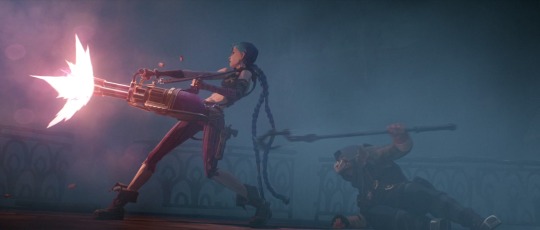
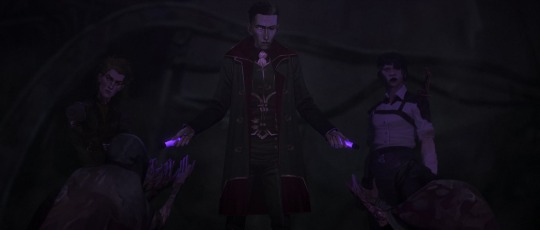
(both trying to kill Zaunites here BTW)
Make no mistake If Silco were black fans would be holding them accountable same with Jinx. But they are white and they are (were) oppressed. That's literally a white liberal dream. They get to ignore the fact that Silco and Jinx are rich and they got rich by oppressing poor people and forcing children into child labor.

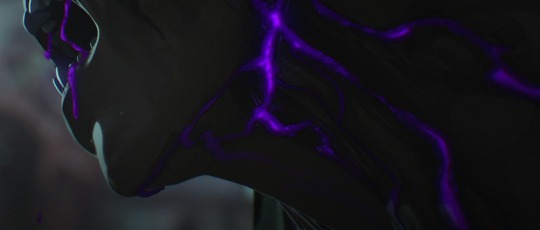
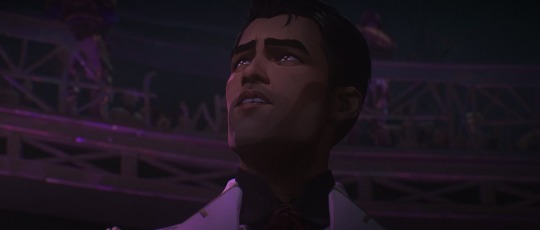
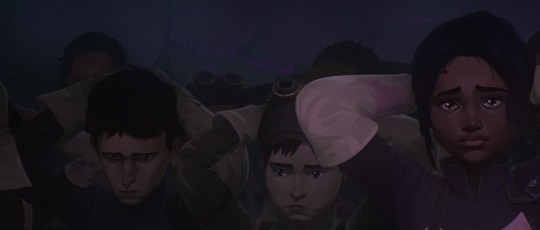
(that Zaunite teen boy died not that anyone cares. )
They get to weaponize classism to excuse the violence and murder they commit against other poor people. Who cares how many orphans he creates or how many poor children he tries to murder.
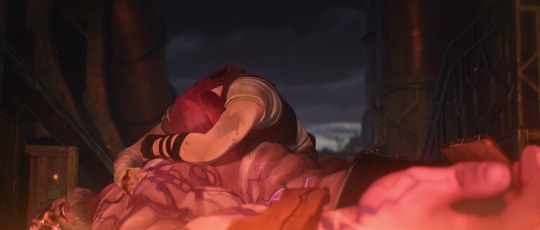
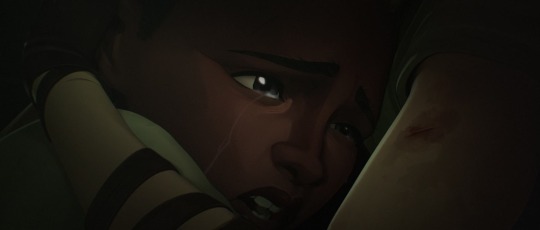
Mind you not only was Silco rich off the backs of poor people and the labor of kids, he used the enforcers to help him not only oppress his own people but also frame Ekko (ironically a BM) and the Firelights for crimes he and Jinx were committing.
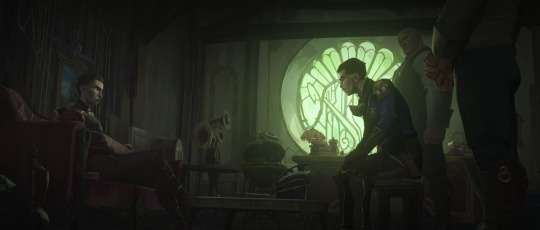
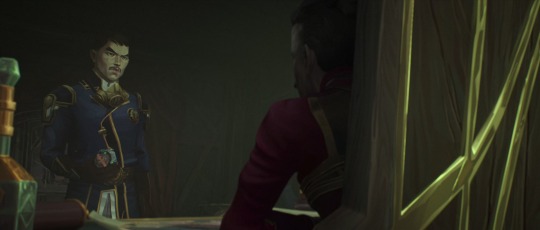
Jinx who killed multiple Zaunites on purpose and tried to kill Ekko later on. Jinx who is rich and has no motive for the violence she commits. Jinx who is working for the man she KNOWS killed her father figure and tried to kill her siblings. Jinx who never once takes responsibility for any of the choices she makes. But she's white. It's why the fandom supports her hetero ship with Ekko (who they headcanon as being her emotional crutch). They only care about heteronormativity when there is a black woman they want to erase. No other straight pairing gets called "disgusting", "forced", "shoehorned", "a betrayal", or "immoral". Mel is forceful and aggressive. She's a seductress who manipulates Jayce into her bed and into doing her evil deeds.
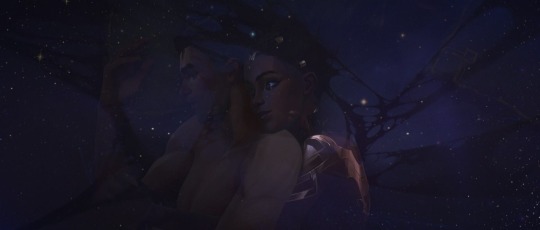
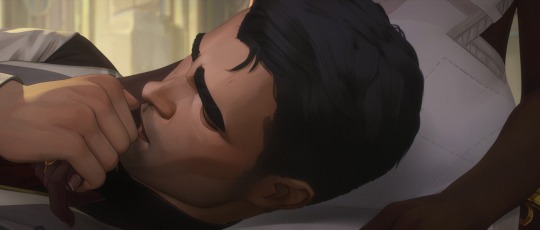
(He's clearly not into her at all)
He should be kissing Vik's ass and worshipping the ground he walks on. Speaking of Viktor ...him using tech for his own gains, secretly merging his DNA with the core, getting addicted to shimmer, killing a fellow Zaunite and converting up her death + stealing her notes is something no one will discuss.
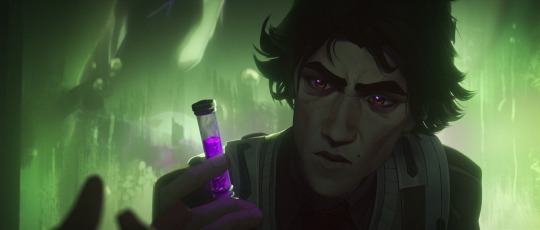
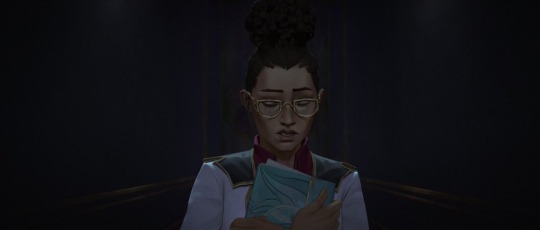

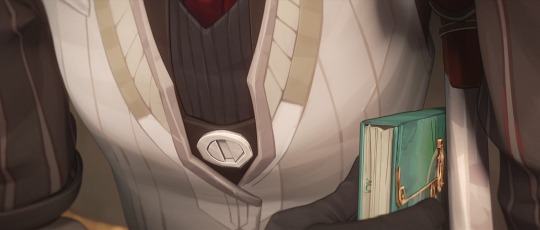
Because he's white , was once poor, and is "gay-coded". He's thus entitled to murdering a brown woman and entitled to Jayce's body. They weaponize LGBTQ+ rep in order to justify their racism much like the left does in real life.
Mel who shows no ill will towards Viktor is accused of being ableist and classist because she gave him a look when he was arguing with her. Mel who explains why she wants defensive weapons and has several scenes reiterating her motive is accused of wanting war and genocide.
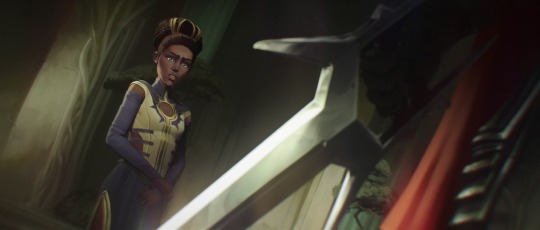
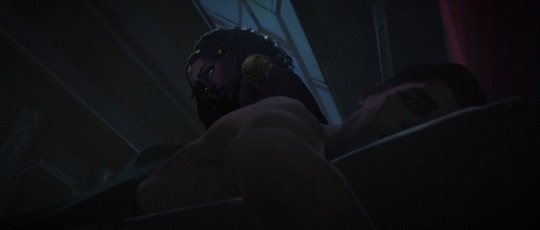
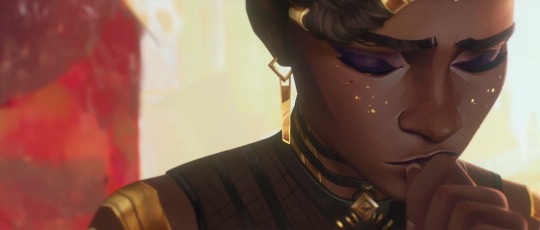

Mel who has exchanged flirty looks with Jayce every episode before she kisses him is accused of raping him. Mel who isn't at all a part of the Vander/Silco/Jinx shenanigans in ep 1 is blamed for the death of Jinx's family because she "controls the council" (even though they often vote against her and Heimerdinger gets a pass despite being there when the cities were founded). Because she's black and rich. Thus they can weaponize poverty in order to villainize BW.
They shout over the people who are actually oppressed. Over the people who know what it's like to have drug dealers and gangs make your life hell while the government does the same on a less personal scale.
This is what white liberals do. It's not new. I won't even get into the weird ass envy/hatred/lust thing they have for bw. The dehumanizing and hypersexualizing shit they do is a whole other essay.
95 notes
·
View notes